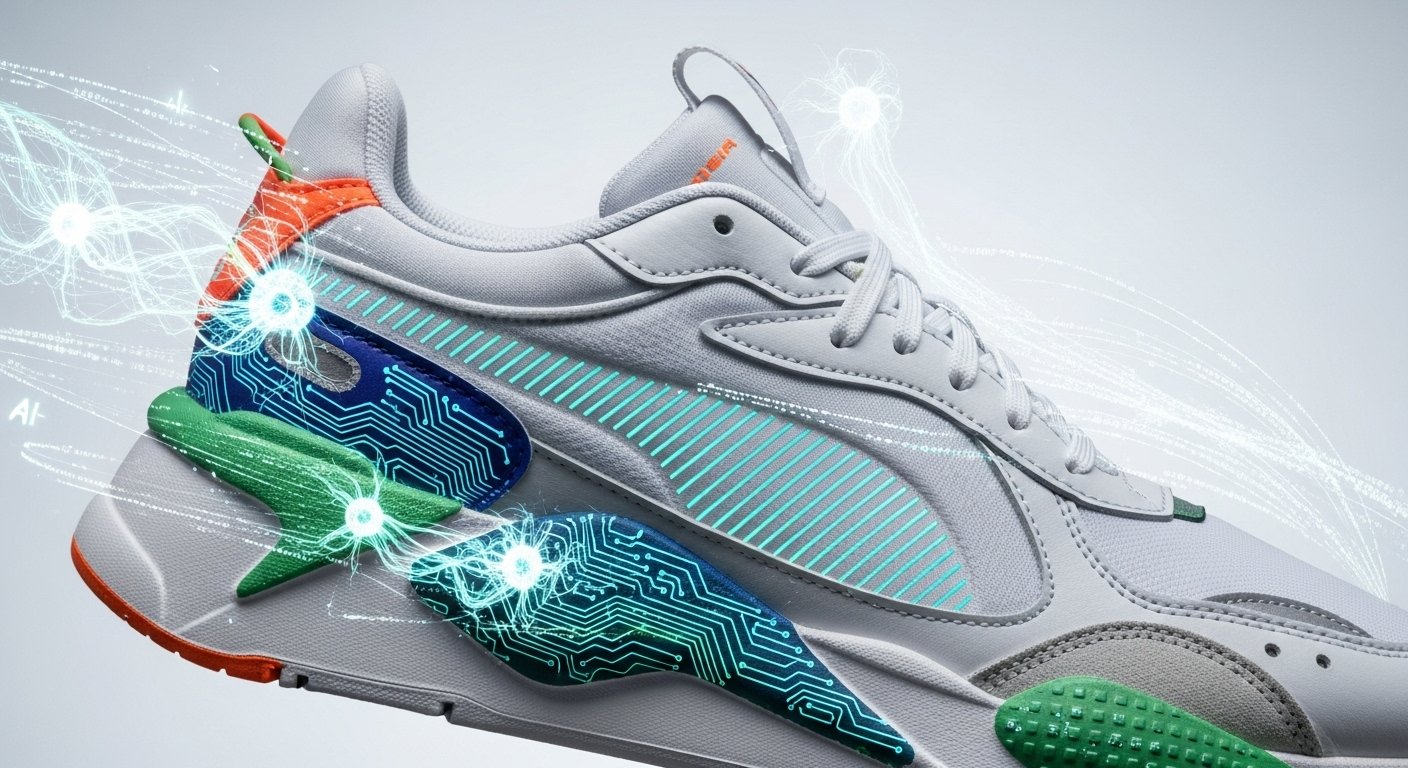In today’s fast-changing digital landscape, brands are racing to blend creativity with technology. Enter Puma’s AI agent ad — a campaign that marks a revolutionary step in how brands ideate, produce, and deliver storytelling.
In early 2025, Puma unveiled an ad fully generated by autonomous AI agents, developed in partnership with the creative tech agency Media.Monks. The project was more than a marketing stunt; it was a living experiment in what happens when artificial intelligence takes the creative wheel.
This campaign grabbed headlines worldwide — not only for its futuristic visuals but for what it means for the future of creative work, speed to market, and AI-driven storytelling.
What Is the Puma and AI Agent Ad?
The Puma AI agent ad is a short, visually captivating campaign designed entirely by hundreds of AI agents — each specializing in different creative and strategic roles.
Unlike traditional advertising, where human teams handle ideation, scripting, animation, and editing, Puma’s campaign relied on AI systems trained to simulate these functions autonomously. These agents worked together like a digital creative team — brainstorming, scripting, designing, and refining content collaboratively.
The result?
An ad that was conceptualized, generated, and optimized by machines in just five weeks — a process that normally takes months.
How Puma Used AI Agents to Create the Ad
Puma’s campaign used a multi-agent architecture — meaning each AI agent had a specialized task. Here’s a breakdown of how it worked:
-
Idea Generation Agents: These AIs brainstormed multiple creative directions based on Puma’s brand values and campaign goals.
-
Scriptwriting Agents: Natural-language models wrote narrative scripts aligned with target audience personas.
-
Visual Design Agents: Generative image and video models created storyboards, color palettes, and environments.
-
Music and Voice Agents: Audio AI tools generated background scores and synthetic voiceovers to match tone and emotion.
-
Optimization Agents: These AIs tested creative variants for engagement, recall, and emotional response before finalizing the winning version.
In essence, Puma built a miniature AI creative department that handled end-to-end ad production — from concept to completion.
The Role of Media.Monks in Puma’s AI Project
The creative production company Media.Monks partnered with Puma to manage this experiment. Their expertise in AI and digital storytelling helped orchestrate the collaboration between hundreds of AI systems.
According to the team, the goal wasn’t to remove humans from the process — it was to augment human creativity. Human strategists supervised, refined prompts, and curated AI outputs to maintain brand consistency and emotional depth.
As one creative director at Media.Monks explained,
“AI didn’t replace the creative team — it became a creative collaborator that helped us think faster, iterate more, and take risks we normally couldn’t afford.”
Why the Puma AI Agent Ad Matters
1. It Redefines the Speed of Creativity
Traditional advertising cycles can take 3–6 months. Puma’s AI-generated ad was built in just 5 weeks.
That’s a 70% reduction in production time — a staggering efficiency leap for global brands.
2. It Demonstrates Scalable Personalization
Because AI agents can test and tailor content quickly, the same framework could be used to generate localized versions for different markets — a dream for global advertisers.
3. It Sparks Debate About the Future of Creativity
The campaign raised a powerful question: Can AI be truly creative, or is it just simulating creativity?
Many marketers praised Puma’s innovation, while others feared a loss of emotional depth in AI-generated storytelling.
The Technology Behind the Puma AI Agent Ad
The Puma AI campaign leveraged several forms of AI technology:
-
Large Language Models (LLMs) for concept writing and dialogue.
-
Generative Visual Models like diffusion-based tools to produce images, animation frames, and VFX.
-
Autonomous AI Agents for task delegation and collaboration (similar to “swarms” or “agentic systems”).
-
Data-Driven Analytics for measuring creative effectiveness, engagement, and emotional response.
These tools were connected through an agentic workflow — meaning the AI systems communicated, learned, and iterated without constant human input.
Performance: Did the AI Ad Actually Work?
According to analysis by WARC (World Advertising Research Center), the Puma AI ad achieved a Creative Effectiveness Score (CES) of 6.38 out of 10, which is above the industry average of 5.8.
The ad scored highly on:
-
Visual engagement
-
Brand recognition
-
Innovation perception
However, it underperformed slightly on emotional resonance, suggesting that while AI can mimic style and logic, human empathy still plays a vital role in storytelling.
Real-World Impact: Puma’s AI Experiment as a Case Study
Puma’s AI-driven campaign wasn’t just about flashy tech. It became a case study in innovation for the entire marketing industry.
Brand Perception
-
Puma was seen as a technology-forward brand, appealing to Gen Z consumers who admire bold innovation.
-
The campaign increased Puma’s social media engagement by over 30% during its launch period, as reported by marketing analytics firm Sonata Insights.
Industry Ripple Effect
Since the ad’s debut, multiple brands — including Nike, Adidas, and Under Armour — have reportedly begun testing their own AI-agent frameworks for rapid creative prototyping.
Puma’s Creative Philosophy: Blending Human and Machine Intelligence
Rather than replacing creatives, Puma’s experiment showcased a collaborative future where humans set strategy and emotion while AI handles execution and optimization.
Puma’s marketing head summarized this shift best:
“AI gives us the speed and scale, but human intuition gives us purpose. When you merge both, that’s where true creative magic happens.”
This philosophy aligns with the broader AI-human co-creation trend — a model where brands empower creative teams with intelligent tools rather than automating them out of existence.
Challenges and Criticisms
Despite its success, the Puma AI agent ad wasn’t without critique.
-
Lack of Emotional Warmth
Some critics felt the ad looked too polished and too safe, lacking the spontaneity of human storytelling.
Emotional depth is still an area where AI struggles. -
Ethical and Copyright Concerns
Using AI-generated imagery and voices raises legal questions about ownership, originality, and data rights. -
Creative Homogenization
Because many AI models are trained on the same datasets, some feared that ads could start to look similar across brands — reducing uniqueness.
These discussions are vital as the industry navigates the balance between innovation and authenticity.
The Marketing Takeaway: Lessons from Puma’s AI Agent Ad
1. Experimentation Is the Future
Brands that dare to test new technologies — like Puma — will gain valuable learning before AI becomes mainstream.
2. Speed Is the New Competitive Edge
The 5-week production cycle shows how AI can dramatically compress timelines without sacrificing quality.
3. Authenticity Still Matters
Even in AI-driven marketing, audiences crave emotional connection and storytelling grounded in human truth.
4. AI Is a Co-Pilot, Not a Replacement
The best results come from AI-human collaboration, not automation in isolation.
How the Puma AI Ad Sets a New Standard for the Industry
The Puma and AI agent ad has become a benchmark in the evolving world of marketing technology. It demonstrates that:
-
AI agents can coordinate like creative teams.
-
Complex ad production can be automated without losing brand coherence.
-
Experimentation can enhance brand relevance in a tech-savvy marketplace.
This campaign will likely inspire future AI-generated commercials, interactive digital ads, and personalized brand experiences powered by multi-agent systems.
The Bigger Picture: AI Agents and the Creative Revolution
The rise of AI agents — systems that think, plan, and collaborate — is changing not only how ads are made but how ideas are born.
Within the next few years, we may see:
-
AI creative directors proposing campaign strategies
-
Autonomous influencer avatars representing brands online
-
Personalized ad storytelling generated for every viewer
Puma’s experiment is an early glimpse of that future — one where creativity becomes a conversation between humans and intelligent machines.
Conclusion
The Puma and AI agent ad wasn’t just another digital campaign — it was a bold statement about the next chapter of marketing.
By merging technology, creativity, and courage, Puma proved that AI can be a collaborator, not a competitor, in the world of storytelling.
As brands continue exploring this frontier, the real winners will be those who balance AI’s efficiency with human authenticity — creating stories that are not only smart but truly meaningful.
FAQs
Q1. What is the Puma and AI Agent Ad?
It’s an AI-generated advertising campaign created by Puma using hundreds of autonomous AI agents to design, script, and produce the ad in just five weeks.
Q2. Who developed the ad for Puma?
The campaign was developed in partnership with the digital creative agency Media.Monks, known for its innovation in AI-driven production.
Q3. Was the Puma AI ad successful?
Yes. The ad scored 6.38/10 on the Creative Effectiveness Scale (CES) — higher than the industry average — and improved social engagement by more than 30%.
Q4. What technology was used in the campaign?
Puma used a combination of large language models, visual diffusion AIs, and autonomous agent systems for ideation, generation, and optimization.
Q5. What does this mean for the future of advertising?
It signals a shift toward AI-assisted creative ecosystems, where machines help brands scale faster while humans focus on strategy and storytelling.








Leave a Reply